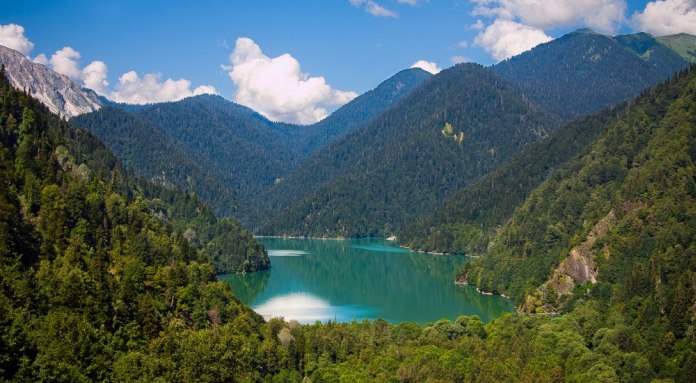World Water Day: A Global Focus and Local Action, by Rene Wadlow

Lake Ritsa
May your heart be like a lake — with a calm still surface and great depths of kindness.
Since 1993, the United Nations General Assembly has proclaimed 22 March as World Day for Water. Each year one of the UN agencies involved in water issues takes the lead in promoting World Water Day with a specific focus and a theme. For 2012, it is the UN Food and Agriculture Organization (FAO) which is the lead agency with a focus on food security and the theme “The World is Thirsty Because We are Hungry.”
From the June 2008 World Food Security Conference at the FAO headquarters in Rome, there has been an emphasis on cooperation among the UN family of agencies, national governments, non-governmental organizations, and the millions of food producers to overcome lack of food and malnutrition due to high food prices, inadequate distribution and situations of violence.
The fluctuation in global agricultural markets is leading to higher food prices and is a threat to world food security. The impact falls heaviest on the poor who spend a high percentage — up to 70 percent — of their income on food. Often, the lack of dietary diversification aggravates the problem, as price increases in one staple cannot easily be compensated by switching to other foods.
Attention must be given to local issues of food production, distribution, and food security. Attention also needs to be given to cultural factors such as the division of labour between women and men in agriculture and rural development, in marketing local food products, to the role of small farmers, to the role of landless agricultural labour and to land-holding patterns.
There is also a need to focus on longer-range and structural issues of which the use — and misuse — of water is very important. Thus the theme of this year’s Water Day linking hunger and thirst. While it is important to develop a world food policy — a theme that world citizens have stressed since the creation of the FAO in 1946, there is also a need for local action in which many individuals, local associations and schools can cooperate. Thus world citizens have proposed a “Adopt a Stream” initiative.
Adopt a Stream
Nearly everyone lives in a river watershed area, and many of us live near a river or a stream. When rain is plentiful, creeks tumble down every slope. When rainfall is scarce, houses and towns cluster around the occasional watercourse or oasis. Farms water crops and livestock from nearby streams. Historically, important cities of economic and cultural life have developed on the edges of rivers. While the protection of larger rivers is a task for central governments and of often multi-State agencies, we as individuals can help restore, protect and enhance a stream at a local level.
By discovering and then monitoring springs and streams that flow near our houses, farms and schools, we can discover the way that water impacts with all life around us, humans, animals, insects and plants. A stream and the vegetation bordering it form one of the richest and most fascinating of wildlife habitats. With some effort and patience, we are rewarded by glimpses into the working of Nature and the relatedness of all aspects of life. The physical forces that shape life in rushing waters are universal and help remind us of the unity of life. Thus, as human populations increase, it is important for us to realize that every drop of water that we use — or waste — is subtracted from our streams and the underground water table.
Streams play vital roles in Nature. They serve as a source of water for nearby plants, wildlife, and aquatic animals. Over time, a stream can shape the landscape. The stream is also part of a larger ecological system. Every drop of rain that falls reminds us that we are part of a universal system that covers the earth’s surface. The Earth is our Common Home. Therefore we must protect it together. We are developing a collective consensus based on solidarity, interdependence and respect for Nature about the quality of life that we want to have as a world society.
The World Citizen initiative “Adopt a Stream” is an effort to create an awareness of the value of each spring and stream, and to understand how our individual and societal actions impact the stream. The costs — and benefits — of the protection of streams is personal as well as communal. We need to live in harmony with the streams and rivers near us. “Adopt a Stream” is doubly educational. We ourselves learn from participating and touch a broader public as well. Projects done with school children can influence and interest their parents.
School projects are especially important as they help students to observe closely, to learn scientific principles, and to understand complex interrelationships with the aquatic environment. The value of a stream project can illustrate relationships and processes as no text book lessons on fishes, animal life cycles, or water quality can do. Information-gathering is the crucial first step. Where does the stream come from and where does it go? What appears to be the stream’s biological and physical limitations? What is the frequency of flooding or drying up?
Thus, as we mark World Water Day, the “Adopt a Stream” initiative gives us also a longer-range focus, the importance of linking the local to the global and the value of learning the wise use of all the resources of Nature.
Rene Wadlow, President and Representative to the United Nations, Geneva, Association of World Citizens